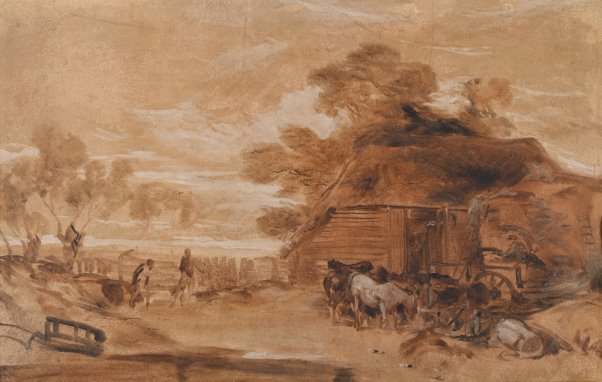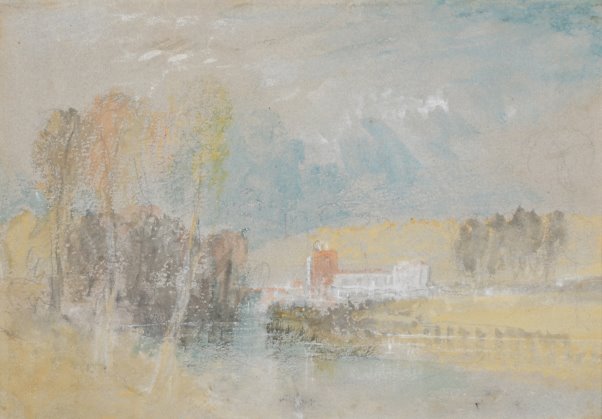JMW Turner’s The Straw Yard at Dreweatts
Joseph Mallord William Turner’s The Straw Yard, from the celebrated Liber Studiorum (Latin for ‘book studies’) is to be offered at Dreweatts Auctioneers on June 12.
The project is considered to be one of the most important artistic achievements of the great English Romantic artist’s career. The work titled The Straw Yard is an oil study of a rustic scene, with horses standing in front of a thatched barn, while men load bales onto a haystack. It is the only known version in oil of a subject in this series, which was conceived by Turner to explore his ideas on landscape painting. All other works in the Liber Studiorum series were etchings.

The Liber Studiorum project was vast, with Turner categorising works by subject such as, ‘Mountainous’, ‘Marine’, ‘Historical’ and ‘Pastoral’. There were further broken sub-categories such as: ‘Modern-Day Country Scenes’, into which category The Straw Yard falls. The study was initially untitled when it was published in 1808 and became known as The Straw Yard by early scholars and collectors of the Liber.
Initially intended as a series of 100 mezzotints, the Liber became one of the most important achievements of Turner’s career during the 19th century. It was never fully finished, however a total of 71 mezzotints were presented in 14 parts with a frontispiece, over a period of 12 years between 1807 and 1817. Art historian Gillian Forrester notes: “To form the compositions Turner created brown watercolour drawings and then etched outlines on to copper plates. He then collaborated with professional engravers, who under his direction created his scenes, in order to create prints.”
The Straw Yard was produced at the same time as its engraved version (plate 7 in part II of the Liber, published in 1808) and is in the same direction as the engraved version and compositionally closer to the print than the preparatory drawing. Art experts have debated on the various hypotheses of why this particular work was created in oil, however art historian Gillian Forrester believes that it might have been a way for Turner to “explore the balance of light and shade in the composition”, which seems the most likely, especially as Turner was known as the ‘painter of light.’
This unusual work from Turner’s greatest project, will be offered in Dreweatts’ Old Master, British and European Art sale on June 12, with an estimate of £100,000-£150,000.
Another work by Turner from the same private collection is also being offered – a charming study titled River Landscape in France. The work in soft hues, depicting an indistinct riverbank with trees and a building in the distance, demonstrates a more spontaneous and dynamic painting style that Turner adopted from the 1820’s onwards. The artist became even more fascinated by the effects of light and shadow on his chosen subject and in order to capture the minute changes of form and colour, that develop from ever-changing atmospheric effects, his style became more abstract and experimental. Colour, overall form and an emotional interpretation became a central focus.

It is often difficult to identify the subjects of many of the studies Turner did at this time, not only because of his change in style, but also because he travelled constantly during the 1820s and 1830s throughout Britain and Europe. The technique that he adopted during this period, was to work simultaneously on several sheets at the same time and as they developed they were either rejected or not, as the artist began to see the direction of the finished work. Artist William Leighton Leitch (1804-1883), who was Vice President of the Royal Institute of Painters in Watercolours for over 20 years, described the process following a visit to the artist’s studio, as follows: “There were four drawing-boards, each of which had a handle screwed to the back. Turner, after sketching in his subject in a fluent manner, grasped the handle and plunged the whole drawing into a pail of water by his side. Then, quickly, he washed in the principal hues that he required, flowing tint into tint, until this stage of the work was complete. Leaving the first drawing to dry, he took the second board and repeated the operation. By the time the fourth drawing was laid in, the first would be ready for the finishing touches.”
The late art historian Gerald Wilkinson (1926-1988) noted that: “Most of [these studies] are clearly ends in themselves. Though of potential use in more complex works, they are ideas, thoughts observations, experiments and sometimes they are beginnings given up for one reason or another.”
Frank Barnett who is mentioned in the provenance was the younger brother of Canon Samuel Barnett (1844-1913), the eminent social reformer and Canon of Westminster (from 1906 until his death). While working in the family iron manufacturing company in Bristol, Barnett the younger, was active in local politics as a Liberal Councillor and founded the Bristol Tavern and Club Company, to establish temperance taverns throughout the city. He was assisted for a time by the Anglican priest, social reformist, local politician and writer, Canon Hardwicke Drummond Rawnsley (1851-1920), who amongst other things, was one of the three founders of the National Trust in 1895, (alongside Octavia Hill and Robert Hunter). Rawnsley had taken an interest in social reform whilst studying at Balliol College, where he came under the influence of the renowned writer, philosopher and art historian, John Ruskin (1819-1900) and through him met Hunter and Hill. Rawnsley married Edith Fletcher in 1878, which suggests that the present study may have been a wedding present to them. It carries an estimate of £70,000-£100,000.


